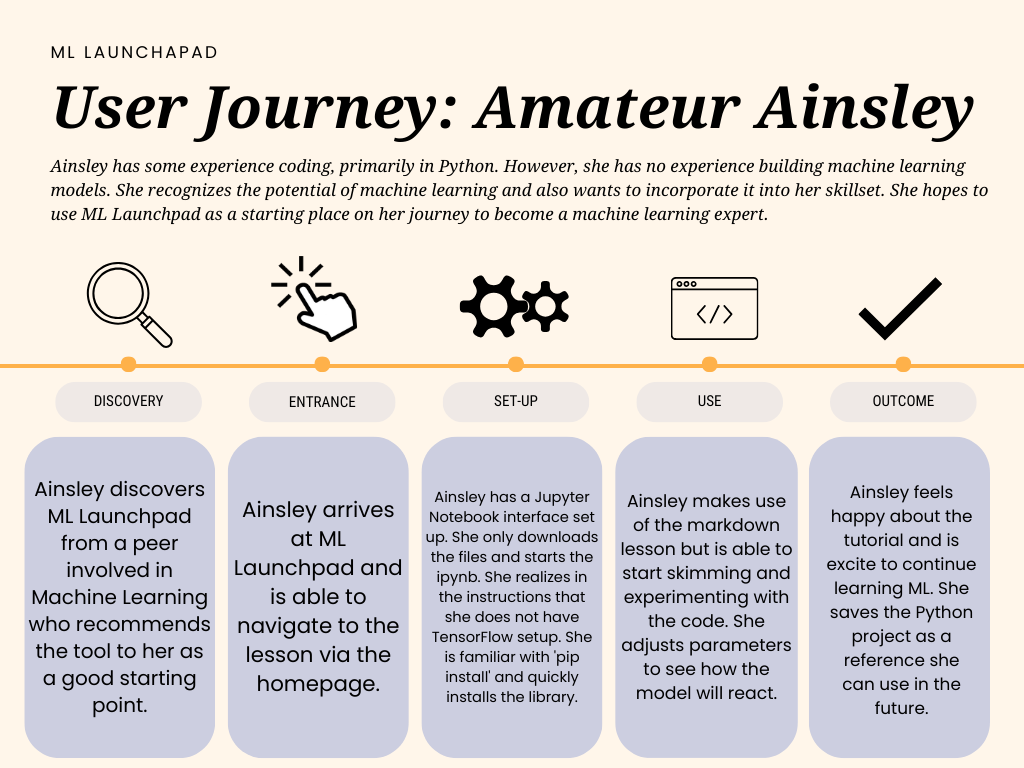How might we…
bridge the gap between complex machine learning concepts and learners new to the field, while making it accessible, fun, and easy to navigate?
This is the question we set out to answer at ML Launchpad.
To do this we focused on 3 key pieces:
User Research
Algorithm Creation
Design Implementation
Our Goals
Make learning complex algorithms accessible.
Create a facial recognition algorithm that prioritizes diversity and eliminates bias.
Equip young developers with increasingly sought after skills.
Engage in a comprehensive design process to deliver a clean product.
User Research
Every great product begins with great user research. Through a survey conducted by the Launchpad team, we discovered that there was a need for a self guided, web-based, machine learning tutorial. The infographic to the right shows some of the key findings which emerged from the survey.
Another key piece of the research process was a literary review and competitive analysis. What we found was that while tools do exist in this space, none of them blended multiple modalities of learning while being specially designed for beginner to intermediate developers.
Our research informed our lesson, development, and design processes so we could best hit our goals and create an accessible platform for users.
Development
The code for ML Launchpad was designed to be easy for anyone to understand. The product was developed using special blend of markdown and actual coding components to best communicate our lesson to everyone.
The coding process began by considering our positionality and determining the best ways to mitigate bias in our training model. We determined that celebrities should be used as the input images since these figures are universal and resonate with people in the specific age demographic we were focusing on. Originally a training set of 15 celebrities with 10 images each was curated. In finality, the model uses four celebrities selected for their diversity and prominence in popular culture. These celebrities were: Oprah Winfrey, Elon Musk, Beyonce, and Cristiano Ronaldo.
The code was written in Python and uses industry standard packages TensorFlow and OpenCV to run at the best rate. The coding process took three months and countless iterations to reach completion. The greatest challenge faced on development was getting the model to predict faces at a high accuracy level.
Design
To align with the core value of ML Launchpad, the code and website interface was designed with accessibility at the forefront. The design process began with identifying the user ‘personas’ of who would interact with ML Launchpad. We settled on two types of people: the beginner and the intermediate coder. On the left you can see the user journeys for the our personas.
To make the best final product we iterated through a classic design process, starting with low fidelity wireframes and working up to a high fidelity prototype, the design you see before you now. To ensure our final design was functional and visually pleasing, we conducted user testing along the way. The most challenging aspect of the design process behind ML Launchpad was creating the best way to communicate technical instructions for the lesson without overloading the user with information. The workflow you see on the ‘Learn’ page is the product of multiple testing sessions and the cleanest way to get beginners or intermediate coders set up with our lesson.
Our product was built with learning in mind. That’s why we have strived to make our website just as informative as it is functional. In designing mllaunchpad.com we paid close attention to incorporating details that discussed machine learning as a whole, not just through the lens of our product.
Want to learn more?
Click here to read our full report with all the nitty gritty details!







